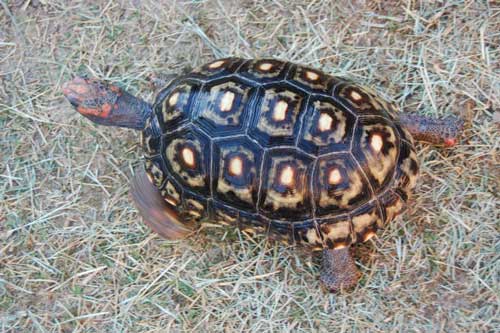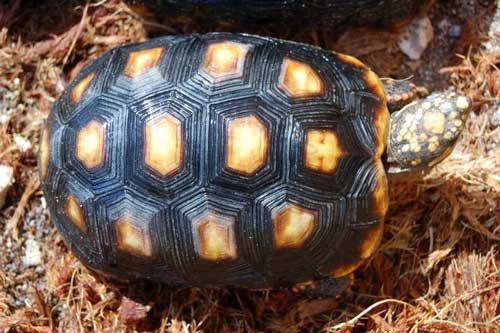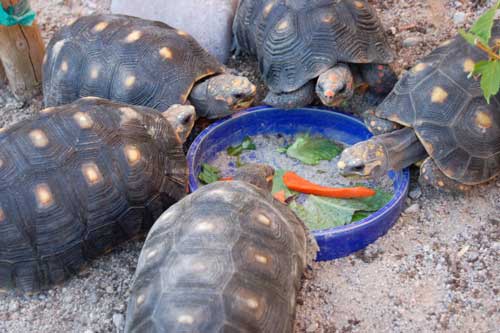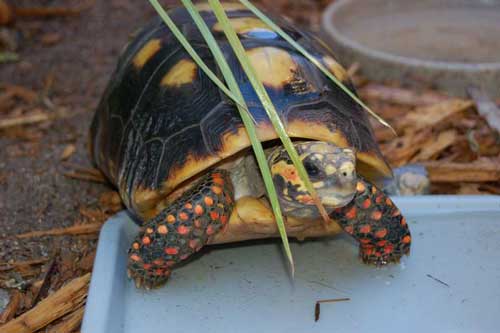Care sheet for the red-footed tortoise (Chelonoidis [Geochelone] carbonaria).
Red-Footed Tortoise (Chelonoidis carbonaria)
Some of the most popular pet tortoises in the United States are the red-footed tortoises of South America. Red-footed tortoises are easy to acquire, are simple to take care of, remain a size that most can easily handle, and they show amazing colorations on their head, legs and shells. Red-footed tortoises are native to moderate climates and have shown an ability to adapt to various climates and habitats in captivity. Red-footed tortoises’ low cost, combined with a curious personality, make them tortoises that are commonly sought after by first-time tortoisekeepers.
Red-Footed Tortoise Availability
Red-footed tortoises are bred on a large scale in the U.S., generally in the humid southern states, where it is easier to keep them outdoors year round. Captive-bred baby red-footed tortoises are available from many sources, including local pet stores, reptile expos and directly from breeders.
Red-footed tortoises are still imported from the wild, mainly from the Suriname and Guyana localities. They are also farm bred in large numbers in South America and shipped into the U.S. after they reach 4 inches in size. Generally these farm-bred animals have somewhat pyramided shells, whereas the wild-caught red-foots are usually smooth shelled. Because of the U.S. 4-inch law, anything smaller than 4 inches in size can be assumed to be U.S. captive bred and born.

Tyler Stewart
8-year-old captive-bred female cherry-head red-footed tortoise.
Red-Footed Tortoise Size
Red-footed tortoise hatchlings measure approximately 1½ to 2 inches in carapace length out of the egg. Growth rates are variable depending on many factors, but are mostly based on the amount and quality of food they are taking in as well as the temperatures they are exposed to.
Red-footed tortoise adult size is generally somewhere between 11 to 14 inches in length, with some exceptions to this rule. We have had females as small as 9 inches in length lay eggs, although it is more likely with females in the 11 to 12 inch range. Like most tortoises, red-footed tortoises grow rapidly for the first five to 10 years, and then their growth slows with age.
Red-Footed Tortoise Life Span
The life span of a red-footed tortoise can vary depending on many factors, but most indications are that they can live for more than 50 years. Tortoises kept in ideal conditions that mimic their natural habitat, without the threat of predation, tend to have higher life spans than tortoises raised in artificial settings.
Red-Footed Tortoise Habitat
Red-footed tortoise enclosures require a sturdy wall at least 16 inches in height above ground, as well as a few inches below ground, to prevent (or discourage) these tortoises from digging. Red-footed tortoises aren’t usually burrowing or digging tortoises, so this isn’t as much of a concern as it would be with other tortoise species. See-through fences and walls should not be used, as the tortoises tend to try to escape through or over these walls if they can see the other side.

Tyler Stewart
Red-footed tortoise enclosures should have walls at lest 16 inches in height above ground and a few inches below ground.
Young red-footed tortoises can be raised indoors if the outside conditions are beyond their tolerance. While outdoor housing is preferred anytime the temperatures are in the acceptable range, many people raise their red-foots indoors for the first few years. Probably the best enclosures to use indoors are simple, plastic sweaterboxes or a “tortoise table,” which you can buy or make yourself. The container itself isn’t as important as the furnishings put into it, which include substrate, lighting, temperature gradients and cage furniture. In colder climates, a suitable enclosure can be built in the garage for large tortoises during the winter. These enclosures should be heated enough to keep the tortoises comfortable during the indoor months.
On top of keeping a moderate humidity level in the enclosure, all baby red-footed tortoises raised indoors should have access to a humid hiding area where they can snuggle in and get a dose of humidity, much like they would in a natural burrow. This more humid microclimate helps their shells to grow smoothly and helps in keeping the tortoise hydrated. Tortoises raised without proper humidity tend to dehydrate quickly and form “bumpy” shells as they grow.
Many different substrates can be used for indoor red-footed tortoise enclosures. For all sizes of tortoise, cypress mulch has proven to be a great bedding. It’s absorbent, safe and relatively low cost. Other good options include coconut coir or peat moss. Outdoor enclosures don’t need fancy substrates, provided that the soil is natural and not tainted with any chemicals or fertilizers.
I also include a few large, flat rocks in the enclosure. They help file down the tortoises’ nails and give them a clean surface for food.
Red-Footed Tortoise Lighting and Temperature
Red-footed tortoises that live outdoors are tolerant to various temperature ranges. High temperatures are generally not going to be a problem provided that the tortoise has a shaded area to escape to if desired and constant access to water to soak in and drink.
We keep our adult red-footed tortoises outdoors in Las Vegas with temperatures of up to 115 degrees Fahrenheit occasionally and have had no losses to heat. Keep in mind the fact that our red-footed tortoise “jungle” is sprayed with sprinklers several times a day, which lowers the overall temperature in that area and raises humidity. The entire area is covered with 80 percent shade cloth.
The tortoises themselves can also handle surprisingly cold temperatures, as low as 45 degrees, with no problems. When nighttime temperatures drop below 50 degrees, a heated hide box should be provided that maintains at least 60 degrees at night (in the 70s is better), or the tortoises should be brought in during those times. Red-footed tortoises are kept outdoors year round in some parts of the country where nighttime lows in the winter are 20 degrees (including here in Las Vegas). It is absolutely required that these tortoises are checked on each evening to make sure they get into a heated area and do not fall asleep out in the open and become exposed to cold temperatures at night.
Indoors, red-footed tortoises can be maintained at normal room temperatures: 68 to 80 degrees. They should also have a basking area heated by an overhead light or a ceramic heat emitter. This warm spot should be in the 90-degree range. While some don’t think it’s needed, we provide a UVB light in the indoor enclosures to help them properly process the calcium in their diets. When placed overhead, it will not lead to eye damage as is sometimes claimed. Lights should run 12 to 14 hours a day, and a mild heat source can be used 24/7 under or over the hide box area (small heat pads, red bulbs or ceramic heat emitters work great for this). Lamp timers make the light cycle consistent and easy.
Red-footed tortoises exist in a wide variety of habitats in the wild, from grassland to jungle, almost all with moderate to high humidity and moderate temperatures. Red-foots can handle variable amounts of humidity in captivity once grown, but babies should be kept humid to ensure proper smooth shell growth in their first few years.
Red-footed tortoises do not hibernate but will go through a winter slow-down period during cooler weather and shortened day-lengths. As adults, red-footed tortoises can safely handle body temperatures as low as 45 degrees at night as long as they are able to heat up into the 70s during the day. Summer temperatures up to 100 degrees can be tolerated as long as there is a cooler, shaded retreat the tortoise can get into. Moisture is not a problem in warmer temperatures (a cool mudhole on a hot day), but the tortoises should be kept dry on cold nights.
Red-Footed Tortoise Food
Red-footed tortoises are typically eager eaters, rarely turning down a meal. With adult tortoises, we feed them the best mix possible of various fruits, veggies, flowers and leaves. They will also graze on mulberry leaves, grape leaves, hibiscus leaves and flowers. They enjoy Mazuri tortoise diet as much as any tortoise does, and having this on hand works well for a backup plan if you can’t get to the store for fresh greens, and it is a good supplemental diet. Mazuri tortoise diet works well to cover any of the nutritional bases that the other diet may have missed.

Tyler Stewart
Feed adult tortoises the best mix possible of various fruits, veggies, flowers and leaves.
We also use spring mixes (particularly with baby red-footed tortoises), which have several leafy ingredients in them, and we supplement with kale, collard greens, turnip greens and any of the darker lettuce types. Cactus pads have become a major part of the diet of many of our tortoises as well. Variety is the key.
It is generally thought that red-footed tortoises need more protein in their diet than many other species. While we don’t offer ours a direct source of protein, they probably do take the opportunity to eat an earthworm or a grub if they come across them in their enclosures. Some keepers offer insects as a supplemental food source (waxworms, mealworms, superworms or earthworms). Some even offer baby mice as a protein source in the diet of their captive red-footed tortoises. Mazuri tortoise diet is higher in protein than a normal vegetarian tortoise diet, so by using this in the diets of our tortoises, we think their needs are being met.
Feed tortoises from a grass surface, flat rock or concrete, or from a tray. Tip – Light-colored trays stay much cooler in the sun and prevent the food from drying out as fast. To prevent them from eating soil or rocks, never feed tortoises directly from a gravel or dirt surface. Red-footed tortoises are grazers and will munch on any plants in their enclosure. We like to use various hibiscus, palm trees and clump grasses in our enclosures to provide them with a somewhat renewable food source.
Red-Footed Tortoise Water
Red-footed tortoises should have water dishes or small ponds in their outdoor enclosures. We use shallow, low-sided dishes that are glazed to make cleaning easy. Cleaning must be done on a regular basis, as most tortoises tend to soak in their dishes and defecate in them. We provide water dishes to our red-footed tortoises all year, although their use of them in the winter is very minimal. We also provide small “mudholes” and puddle-areas that the tortoises can sit in to stay cool during the hot months.
When red-footed tortoises are housed indoors, shallow water dishes can be used, but again, they need very regular cleaning. In shallow water, the tortoises usually begin drinking immediately and flush their systems at the same time. Baby and juvenile red-footed tortoises tend to dry out much quicker than larger, more established tortoises. They can also be soaked outside the enclosure in shallow, warm water once or twice a week for 15 to 30 minutes to get fully hydrated, which also helps keep the main enclosure clean. This is a form of “forced hydration” but works well in keeping the tortoise fully hydrated.
Red-Footed Tortoise Health
For best results, purchase an alert, active red-footed tortoise with bright, clean eyes, or buy one from a reputable source that will guarantee (at least) a live arrival. These tortoises can suffer from most common reptile health problems, but respiratory infections and parasites in the case of imported tortoises are the most prevalent.
Red-footed tortoises can also be prone to respiratory infections if they are kept in cool or wet enclosures. This is evident if the tortoise has a bubbly nose or raspy breathing or makes a gurgling sound as it breathes. In the early stages, it can sometimes be corrected by raising temperatures and lowering humidity for a week or two, but if it gets to the point of bubbling or foaming at the mouth or nose, a vet should be consulted.
Red-Footed Tortoise Handling and Temperament
Contrary to what many sellers tell customers, tortoises generally should not be handled with any regularity. They are easily stressed when over handled, and children tend to drop them when spooked. These stress factors can lead to a decline in a tortoise’s activity levels and health.
Juvenile and older red-footed tortoises are generally more resistant to handling, but all tortoises should be handled carefully. Avoid pinning them down or restricting them. Allow them to carry on in their intended way, especially when they’re young. Older red-footed tortoises are usually pretty tolerant of people.
Tyler Stewart is the source for Red-Footed Tortoise information. Please visit his site at www.TortoiseSupply.com.



